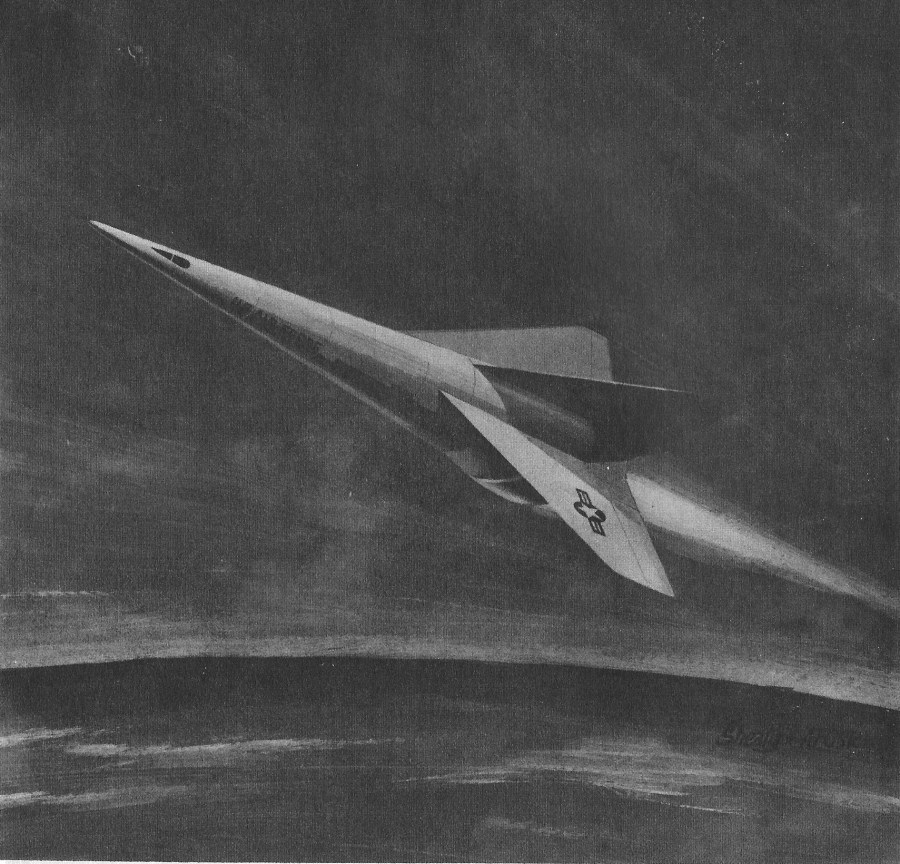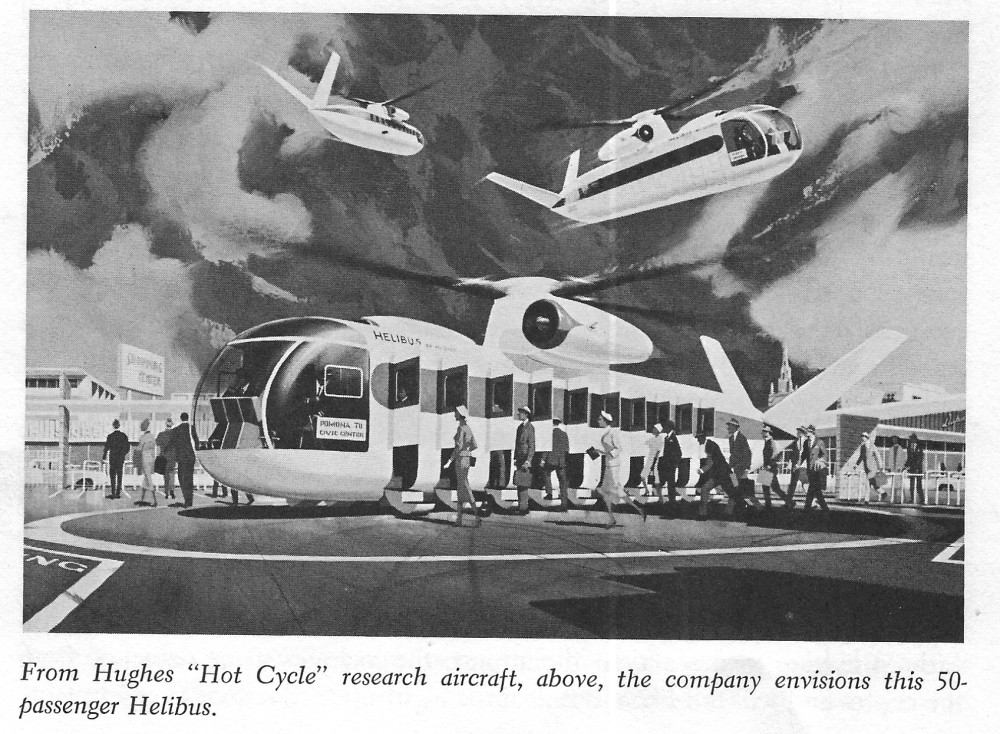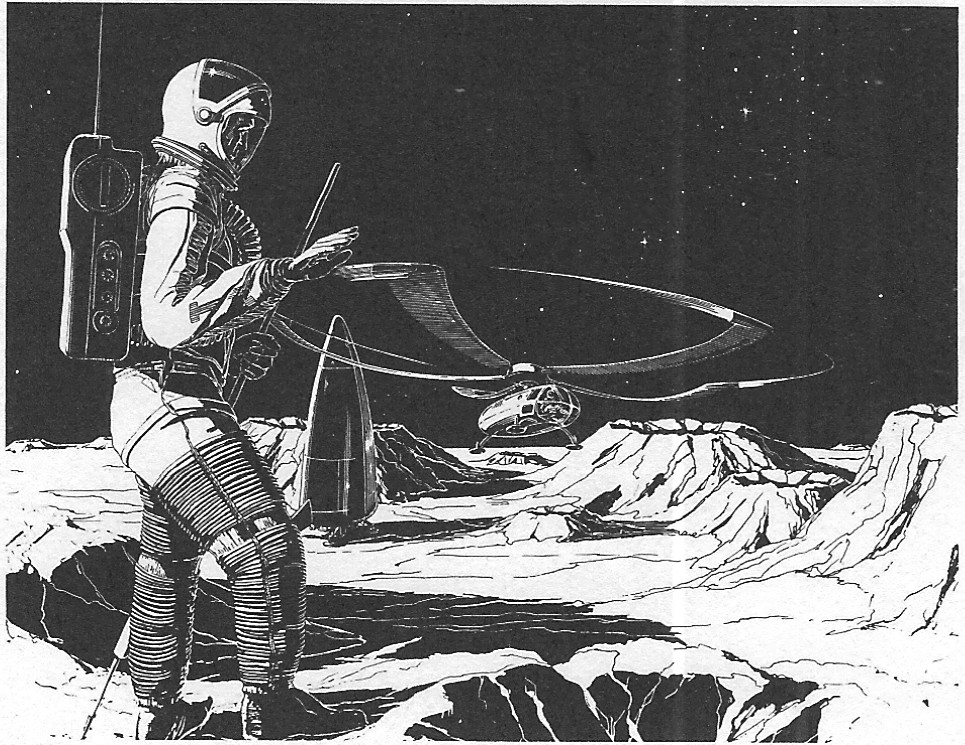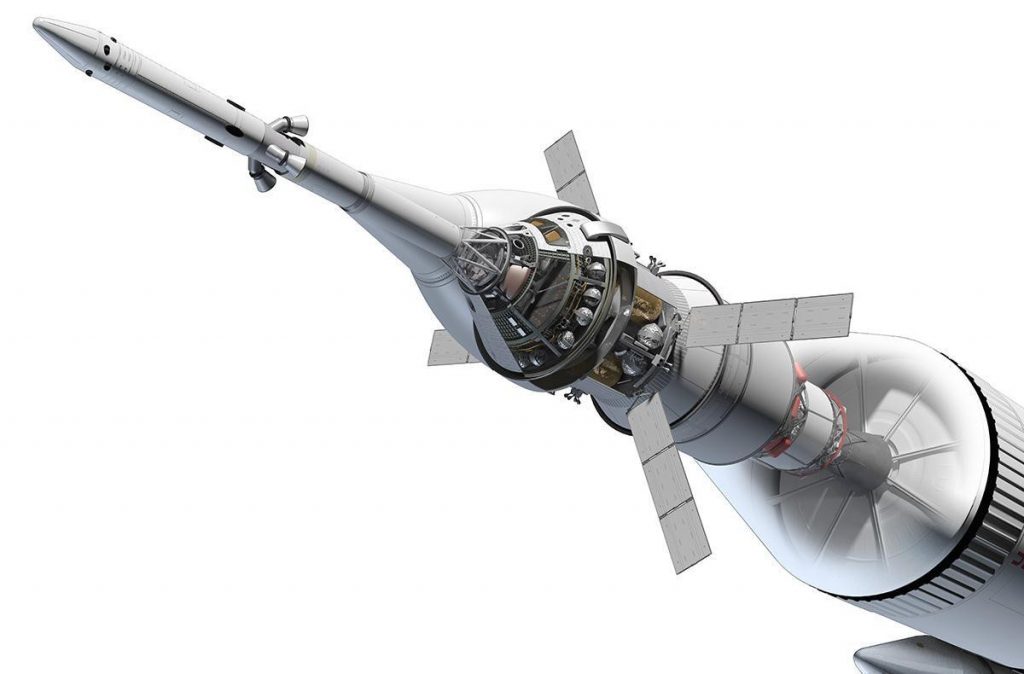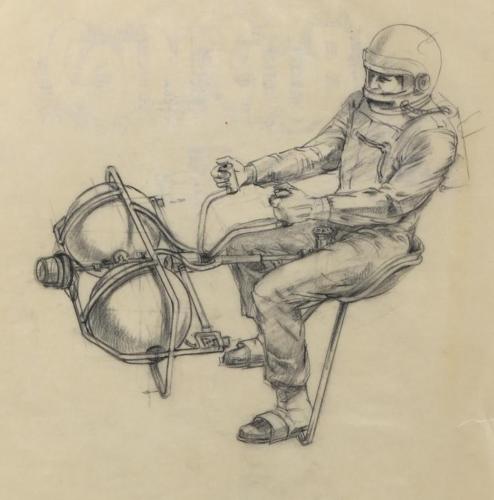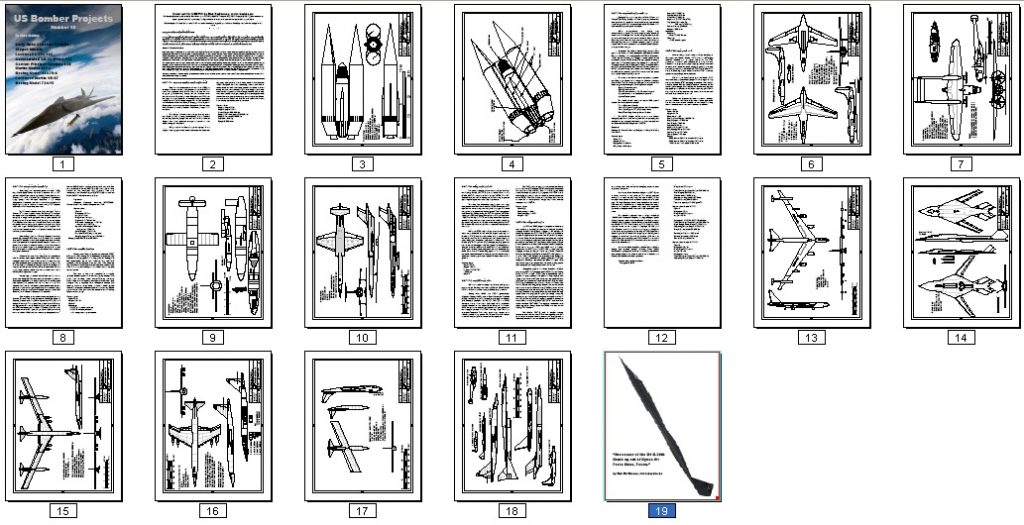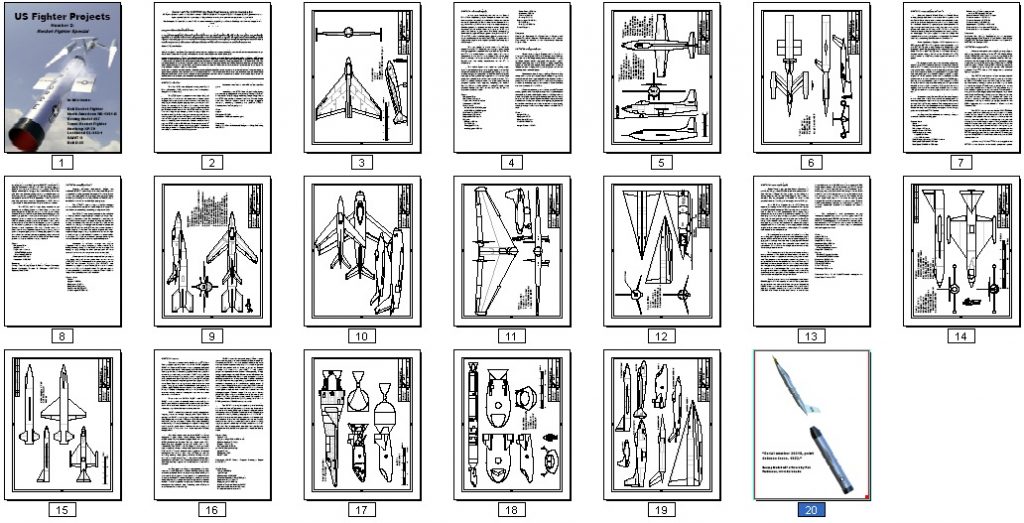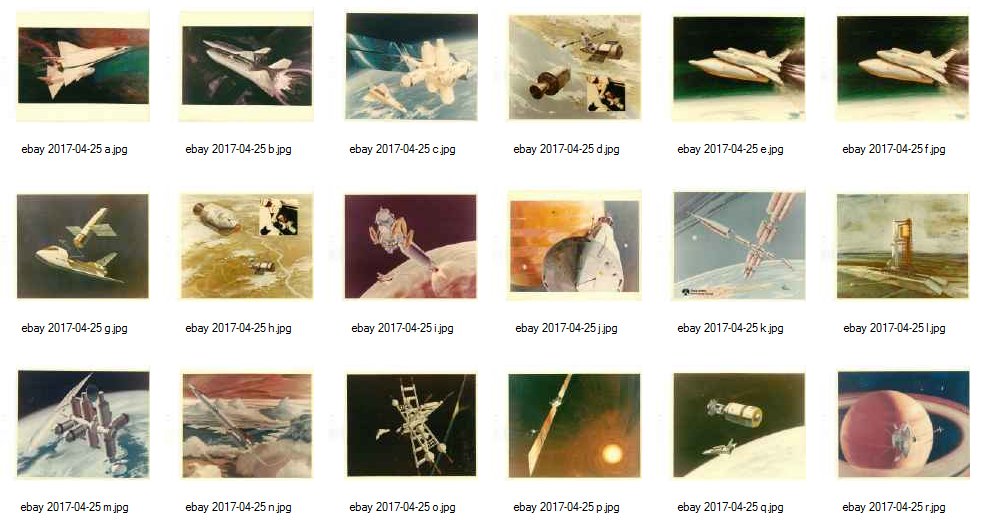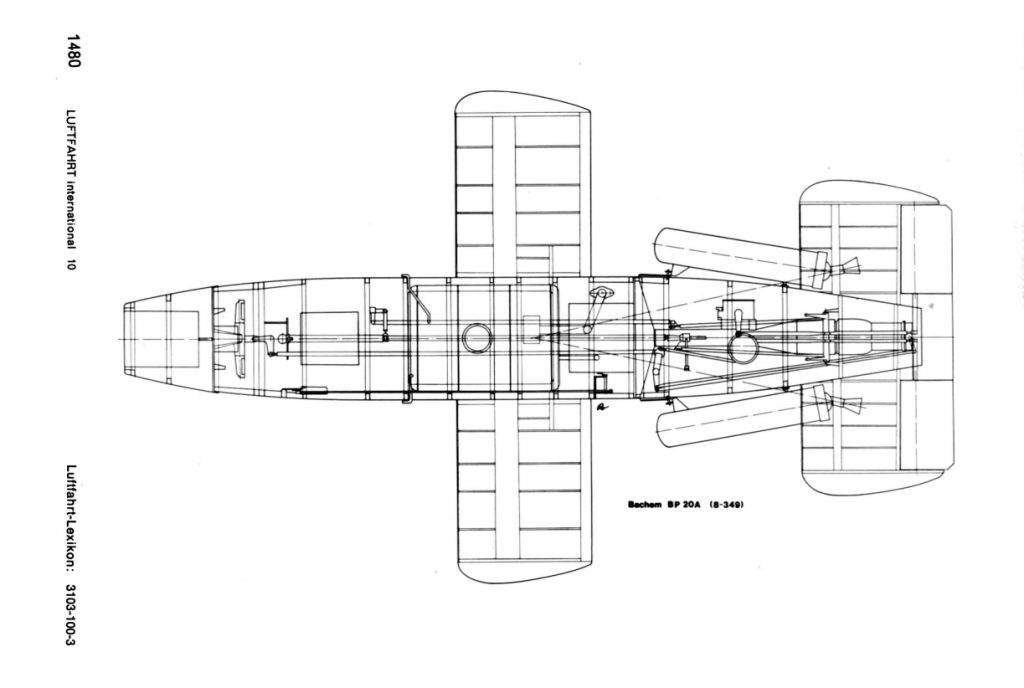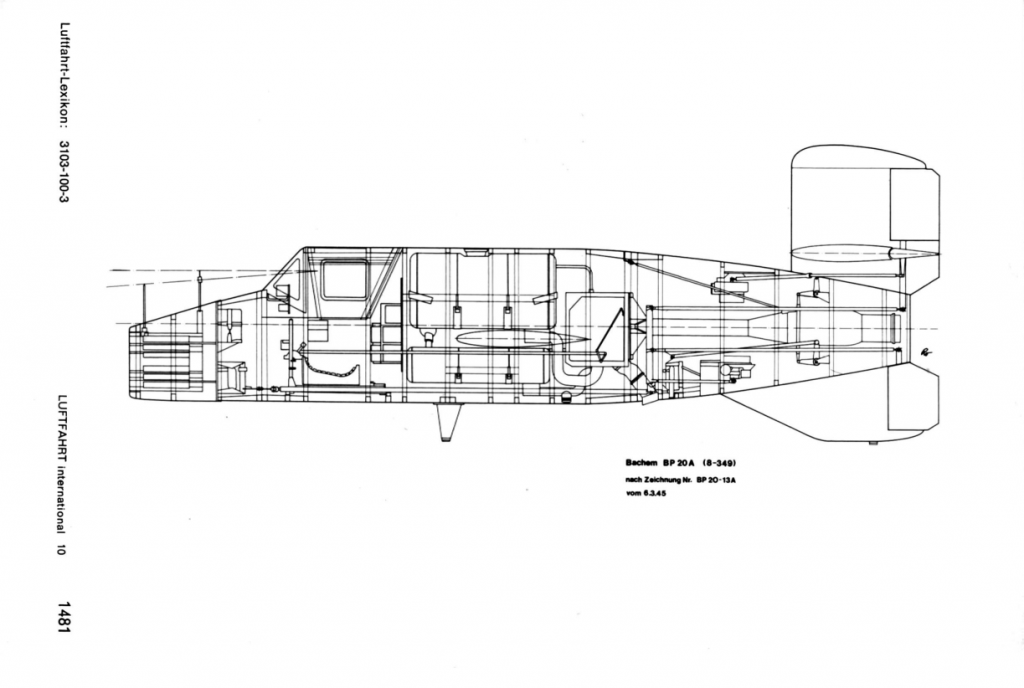Dating from about 1963-63, this is a depiction of a high-altitude research aircraft equipped with “composite air-augmented turbo-jets” for launch and rockets for “near-space operations.” The general configuration was used many times over the decade, typically for scramjet powered aircraft. This was painted by Pat Shealy, chief of the Presentations Division, Air For Office of Scientific Research at Wright-Patterson Air Force Base.
From the very early 1960’s, this piece of Hughes artwork depicts a hot-cycle “Helibus.” The “hot-cycle” was a briefly studied form of helicopter that did not mechanically drive the rotor, but instead ducted hot exhaust gas from a turbojet up into the rotor hub and then down through ducts in the rotors, exhausting out nozzles near the tips of the rotors. The exhaust gas would then push the rotor blades directly. The advantage was that since there was no direct mechanical linkage between the rotors and the fuselage, the torque that a helicopter normally needs to counter with a tail rotor would be largely eliminated. Thus this “Helibus” has no tail rotor, but it would still need to have some sort of reaction control thrusters at the tail to provide directional control at low speed.
Note that every row of passenger seats has its own door. This would greatly facilitate passenger loading and unloading, at some considerable weight and cost penalty. it would also firmly lock in seat pitch… as the engines are swapped out for newer, better, lighter, more powerful and less fuel hungry versions, the airlines drive would be, as we’ve seen, to pack more and more passengers onboard. But here the doors on the side have to precisely match the seat rows.
A vehicle like this would probably be used mostly to transport office drones from rooftop heliports in urban city centers to transport hubs out in the burbs or the sticks.
An old (1962 or before) piece of concept art from Kaman illustrating their “ROMAR,” a helicopter meant for Mars exploration. It appears to be powered by rotortip rockets, a decent enough approach for this sort of thing. However, this was before Mariner mars ’64, when the understood density of the Martian atmosphere dropped by more than a factor of ten. As a result, a helicopter like this would need to be made fabulously low-weight in order to fly, something improbable given the needs of a manned vehicle.
This is, ummm…
This is *not* a NASA concept, but one produced by the “Parker Brothers,” builders of Hollywood prop vehicles. It kinda looks “cool,”which is certainly good from a PR standpoint… but there’s a whole lot about the engineering design that’s head-scratching. Why the concessions to aerodynamics, when that is of approximately zero use in the incredibly thin atmosphere of Mars? Why all the artsy doodads, like the flags and logos that appear to be metal *relief* structures? Why does it look like something Batman would be busy welding Gatling guns to? And I’m frankly stumped by the wheels. They said the “cutouts” are so the wheels don’t get clogged up. Is… is that actually a concern with the incredibly dry Martian sand? Couldn’t rocks get jammed into those cutouts? What’s with the external bars in front of the windshield?Is this thing pressurized? Is it nuclear powered, and can the reactor put out 1.21 gigawatts? Does Jan Michael Vincent keep a dirtbike in the back?
The extremely large Stratolaunch was rolled out of the hangar for the first time today. It’s still a ways away from completion and flight.
Stratolaunch Aircraft Makes First Rollout To Begin Fueling Tests

Currently there is a large, expensive auction on eBay for several hundred pieces of Marquardt concept art. The per-piece price of about ten bucks is pretty good, but the sum total is just a whole lot. Anyway, the auction listing provides a look at a *few* of the pieces, including one that depicts a “space sled.” This was a maneuver vehicle for a single astronaut, with much greater performance than the various maneuvering backpacks that had been designed over the decades. Instead of strapping it on, the pilot sits on it somewhat as if it was a motorcycle. The propellants are almost certainly cold gas (nitrogen) thrusters, which means specific impulse was really low. But it also made them very, very simple devices.
While Marquardt did some serious design work on space sleds, including building one that is currently on display at the USAF Museum in Dayton, it’s unclear how serious this one is. The space suit, after all, is pretty weak. There appear to be only two thrusters, both providing “forward” thrust; steering looks like it might have been by actually tilting the whole assembly. This would have provided only minimal thrust vectoring, and would have provided little to no pitch or roll control, and no braking thrust. My guess is that this was either the art department coming up with a concept on their own without much engineering input, or it was a very preliminary and perhaps unfinished piece.
Now available: two new US Aerospace Projects issues. Cover art was provided by Rob Parthoens, www.baroba.be
US Bomber Projects #19
US Bomber Projects #19 is now available (see HERE for the entire series). Issue #19 includes:
- Early Atlas Concept: Parallel Staged Missile: three-bodied concept leading to the Atlas ICBM
- Lockheed L-286-665: A supersonic nuclear powered design
- Consolidated XA-44 Model 112: a three-engined forward-swept jet
- Convair Pilotless Airplane I-40: a TV & radar guided missile
- Martin Model 151-J: A late pre-war design
- Boeing Model 464-79-0: a long-span B-52 with floating wingtips
- Lockheed-Martin VS-07: A recent stealthy variable geometry concept
- Boeing Model 724-15: Boeings first giant competitor for the B-70
USBP #19 can be downloaded as a PDF file for only $4.25:
——–
US Fighter Projects #02 is now available (see HERE for the entire series). Issue #02 includes:
- Bell Rocket Fighter: A design similar to the X-1
- North American RD-1381-B: A two-stage VTO design
- Boeing Model 457: A rocket boosted ramjet fighter with two stages
- Truax Rocket Fighter: A VTO ship-launched interceptor
- Northrop XP-79: A flying wing with a prone pilot
- Lockheed CL-362-1: A late 1950’s spaceplane-like hypersonic concept
- SAINT II: the Satellite Interceptor lifting body
- Bell D-35: a tailless delta-like design
USFP #02 can be downloaded as a PDF file for only $4.25:
——–
A number of vintage 8X10 glossies of aerospace concept art (all apparently North American/Rockwell) were recently sold on eBay. These included Apollo/Skylab, early Space Shuttle concepts, advanced spacecraft (including a manned mission to Jupiter and NERVA tugs) and various space probes and space station designs. Fortunately, the seller provided fairly good scans. I have collected them and uploaded them to the APR Patreon Extras Dropbox folder for 2017-05. If you are interested in accessing these and other aerospace historical goodies, consider signing up for the APR Patreon.
If there was ever a demonstration of the combination of “technical genius” with “wartime desperation,” it was the Bachem Natter from late in World War II. This German design was a point defense interceptor, from a time when B-17’s, B-24’s and Lancasters freely roamed the sky, laying waste to the German infrastructure. The Natter was a rocket-powered, vertical takeoff, partially reusable manned surface-to-air missile. It was to be armed with a multitude of unguided explosive-tipped rockets in the nose, probably to be launched as a single salvo. Reportedly, someone had the bright idea that the pilot would then aim his plane at another bomber for a ramming attack, bailing out at the last second. But since bailing out meant separating the nose from just forward of the cockpit aft bulkhead, the likelihood is vanishingly low that either the pilot would survive or that the Natter would continue forward in a predictable path. The more reasonable approach would still be for the pilot to bail out, but for both the pilot and the aircraft to pop chute and land safe enough to be recovered and reused.
The Natter was launched unmanned a few times and manned once, killing the pilot. It was *kind* of a neat idea, but the execution was not so good. The Germans would have been better advised to have worked on unmanned surface to air missiles than the Natter. But for all the claims of vaunted German efficiency, the Nazi regime was astonishingly inefficient, with many redundant and non-communicative programs.
Just as well, in retrospect.
There are many photos and illustrations of the Natter out there, but I figured these diagrams might be of interest.
